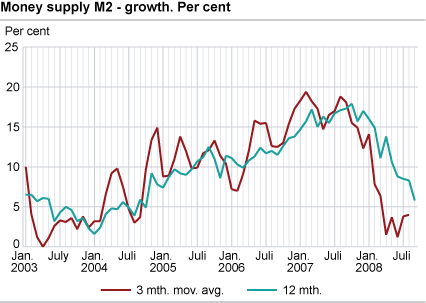Content
Published:
This is an archived release.
Declining growth in money supply
The twelve-month growth in total money supply was 5.8 per cent to end-September, down from 8.3 per cent to end- August. The growth in money supply is now at its lowest since October 2004.
The money supply amounted to NOK 1 462 billion at end-September, down from NOK 1 465 billion at end-August. The annual growth in money supply fell for the fifth month in a row.
Composition of money supply
During the last months there has been a shift in stocks from transaction deposits to other deposits. This can be a consequence of the banks offering higher rates on saving deposits in order to get liquidity. In September the stock of other deposits rose from NOK 599 billion to NOK 616 billion. At the same time the stock of transaction deposits fell from NOK 702 billion to NOK 682 billion.
Declining growth for households
At end-September more than half (NOK 769 billion) of the broad monetary aggregate was owned by households. The twelve-month growth in household money supply fell from 8.2 per cent to 7.2 per cent during September. Households have been the main contributor to annual growth in money supply for nine consecutive months. The growth in household money supply was a little lower than the growth in household gross debt, which was 8.7 per cent to end-September, as shown by the credit indicator C2 . For more information on the financial position of households, see the financial accounts in the national accounts .
Slowdown also in non-financial enterprise money supply growth
Non-financial enterprise money supply amounted to NOK 507 billion at end-September. The twelve-month growth was 2.8 per cent, compared with a yearly growth of 3.9 per cent recorded in the previous month. The twelve-month growth rate has been decreasing since December 2006, when it reached 35.5 per cent. Apart from the last months, we must back to October 2004 to find yearly growth rates below 5 per cent. Non-financial enterprise money supply constituted 44 per cent of their gross domestic debt measured by the credit indicator C2 at end-September, while this share was higher than 50 per cent during most of 2007.
| April 2008 | May 2008 | June 2008 | July 2008 | August 2008 | September 2008 | ||||||||||||||||||||||||||||||||||
|---|---|---|---|---|---|---|---|---|---|---|---|---|---|---|---|---|---|---|---|---|---|---|---|---|---|---|---|---|---|---|---|---|---|---|---|---|---|---|---|
| M0 - 12 mth. | 10.7 | 22.2 | 17.7 | 4.2 | 16.4 | 21.6 | |||||||||||||||||||||||||||||||||
| M1 - 12 mth. | 7.4 | 4.8 | 3.4 | 1.6 | 2.7 | -2.6 | |||||||||||||||||||||||||||||||||
| M2 - 12 mth. | 13.8 | 10.6 | 8.8 | 8.5 | 8.3 | 5.8 | |||||||||||||||||||||||||||||||||
| M2 - 3 mth. moving average | 1.5 | 3.7 | 1.2 | 3.8 | 4.0 | ||||||||||||||||||||||||||||||||||
| M2 households - 12 mth. | 10.2 | 9.5 | 8.6 | 8.2 | 8.2 | 7.2 | |||||||||||||||||||||||||||||||||
| M2 non-financial enterprises - 12 mth. | 10.6 | 6.4 | 4.2 | 4.1 | 3.9 | 2.8 | |||||||||||||||||||||||||||||||||
|
The money supply (broad monetary aggregate) M2 consists of notes and coins, unrestricted bank deposits, certificates of deposit and units in money market funds owned by households, non-financial enterprises, municipalities and financial enterprises other than state lending institutions, banks and money market funds. |
The statistics is published with Monetary aggregates.
Contact
-
Statistics Norway's Information Centre
E-mail: informasjon@ssb.no
tel.: (+47) 21 09 46 42

